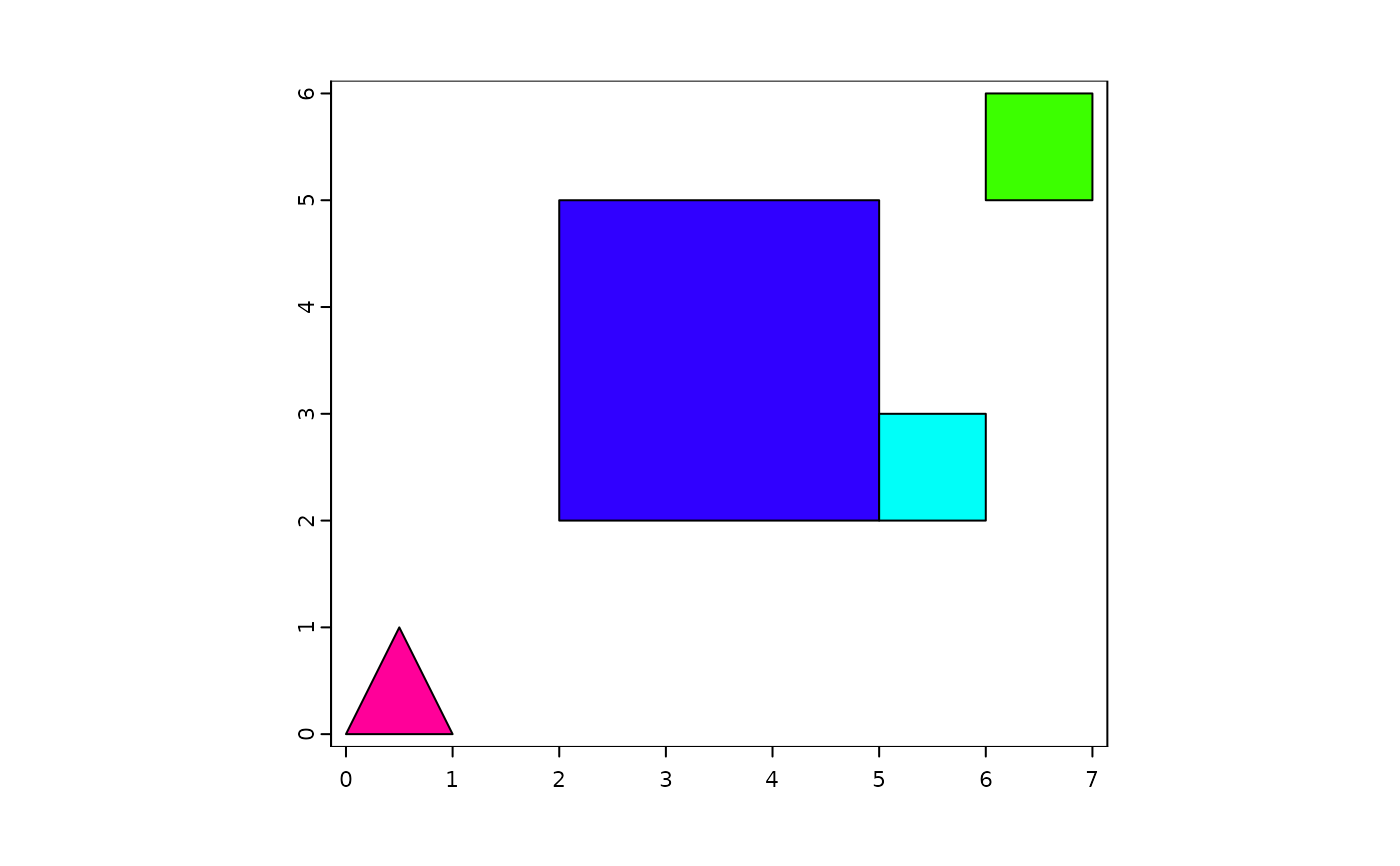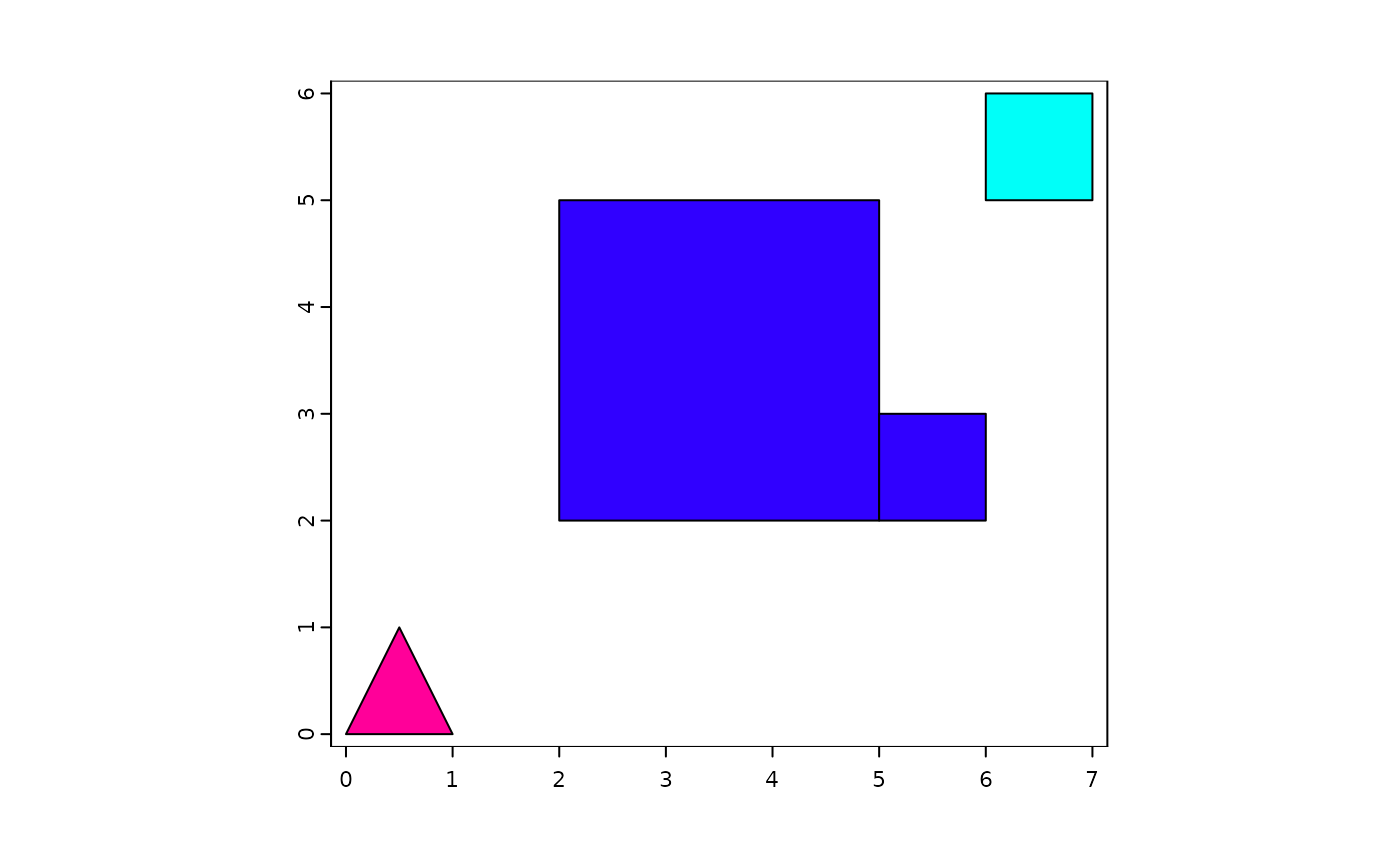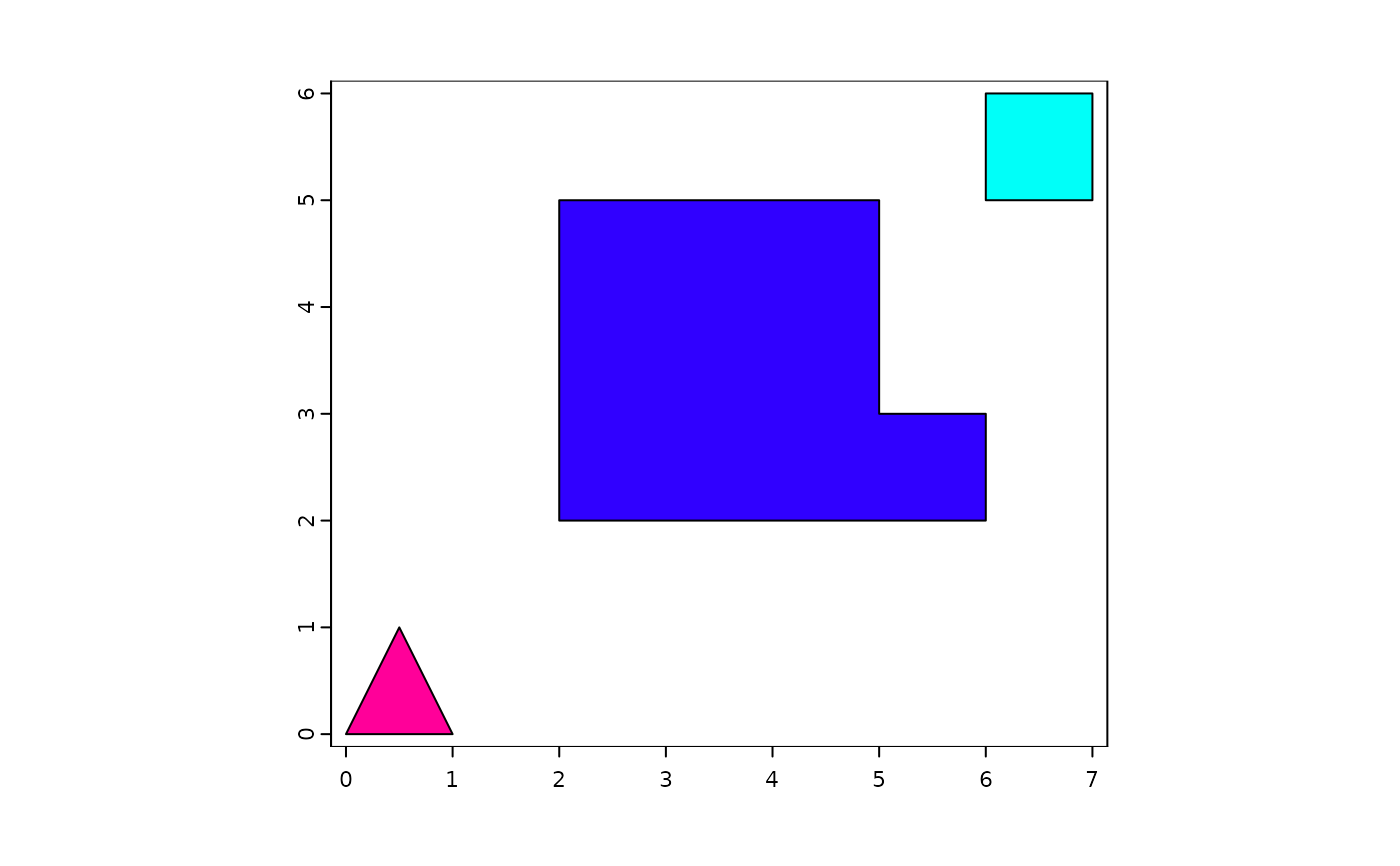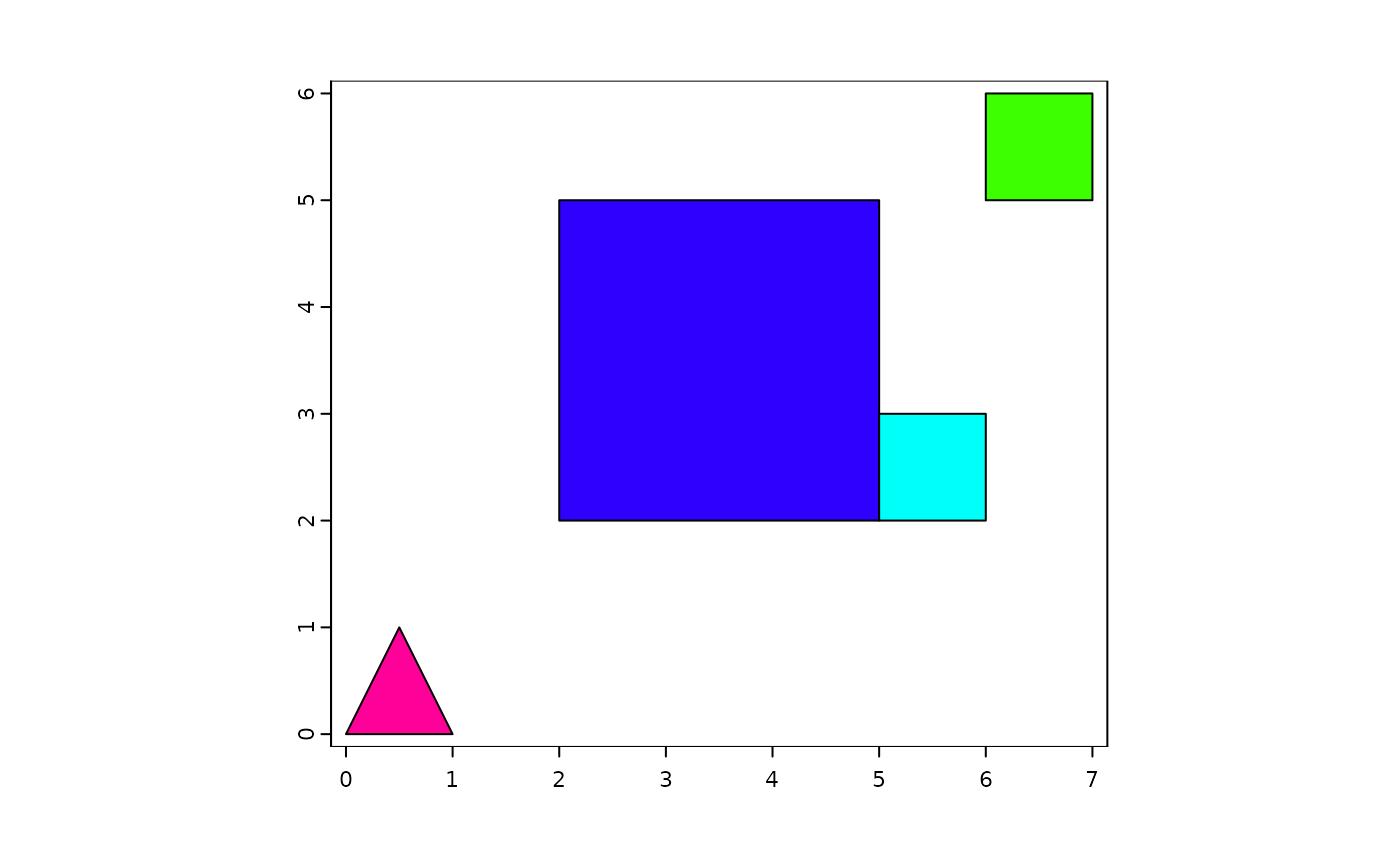Geometries can be either single/simple or multi with multiple closed rings
defined as a single record. combineGeom() is used to combine polygons.
splitGeom() breaks combined geometries down into constituent parts.
Avoid using the SpatVector methods. They are lower-level and does not
deal with IDs like might be expected by Giotto.
Usage
# S4 method for class 'giottoPolygon'
combineGeom(
x,
by = NULL,
dissolve = FALSE,
fun = "mean",
...,
fmt = "poly_%d",
previous_id = "source_id"
)
# S4 method for class 'giottoPolygon'
splitGeom(x, fmt = "poly_%d", previous_id = "source_id", ...)
# S4 method for class 'SpatVector'
combineGeom(x, by = NULL, dissolve = FALSE, fun = "mean", ...)
# S4 method for class 'SpatVector'
splitGeom(x, ...)Arguments
- x
geometry class to combine or split.
- by
character. Column name of variable used to group the geometries. Will be used as the new
poly_IDcolumn. All geometries will be combined if not provided.- dissolve
logical. Should borders between aggregated geometries be dissolved?
- fun
function used to aggregate values. Either an actual function, or for the following, their name: "mean", "max", "min", "median", "sum", "modal", "any", "all", "prod", "which.min", "which.max", "table", "sd" (sample standard deviation) and "std" (population standard deviation)
- ...
additional params to pass to
terra::aggregate()(and then tofun, such asna.rm=TRUE) orterra::disagg()- fmt
character. sprintf formatting to use to generate
poly_IDcolumn values if no attributes are retained after combining.- previous_id
character. If not
NULL, column name to store original poly_ID values under. Note that merged IDs will beNA.
Details
Currently, these are simple wrappers around terra's
aggregate(dissolve = FALSE) and disagg() with some additional handling
around the poly_ID column and a different name to avoid confusion with
spatial feature aggregation.
Geometry Attributes Handling
combineGeom()attributes are only kept ifbyparam is used. For conflicts where more than one value is present for a single variable after combining, they are resolved usingfunparam. Whenby=NULL, all attributes are dropped and a defaultpoly_IDcolumn is generated based on thefmtparam.splitGeom()attributes are duplicated for each part that was part of the same multipolygon. Thepoly_IDcolumn will be made unique.overlaps and centroids information will be dropped after either operation.
Examples
dt <- data.table::data.table(
id = c(
rep('a', 3), # Triangle (id 'a')
rep('b', 4), # Square 1 (id 'b')
rep('c', 4), # Square 2 (id 'c')
rep('d', 4) # Square 3 (id 'd')
),
x = c(
0, 1, 0.5,
2, 5, 5, 2,
5, 5, 6, 6,
6, 7, 7, 6
),
y = c(
0, 0, 1,
2, 2, 5, 5,
2, 3, 3, 2,
5, 5, 6, 6
)
)
plot_colors <- getRainbowColors(4)
gpoly <- createGiottoPolygon(dt, verbose = FALSE)
plot(gpoly, col = plot_colors)
 gpoly$group_id <- sprintf("group_%d", c(1, 2, 2, 3))
gpoly$values <- 1:4
force(gpoly)
#> An object of class giottoPolygon
#> spat_unit : "cell"
#> Spatial Information:
#> class : SpatVector
#> geometry : polygons
#> dimensions : 4, 3 (geometries, attributes)
#> extent : 0, 7, 0, 6 (xmin, xmax, ymin, ymax)
#> coord. ref. :
#> names : poly_ID group_id values
#> type : <chr> <chr> <int>
#> values : a group_1 1
#> b group_2 2
#> c group_2 3
#> centroids : NULL
#> overlaps : NULL
c_all <- combineGeom(gpoly) # combine all
force(c_all)
#> An object of class giottoPolygon
#> spat_unit : "cell"
#> Spatial Information:
#> class : SpatVector
#> geometry : polygons
#> dimensions : 1, 1 (geometries, attributes)
#> extent : 0, 7, 0, 6 (xmin, xmax, ymin, ymax)
#> coord. ref. :
#> names : poly_ID
#> type : <chr>
#> values : poly_1
#> centroids : NULL
#> overlaps : NULL
plot(c_all, col = plot_colors)
gpoly$group_id <- sprintf("group_%d", c(1, 2, 2, 3))
gpoly$values <- 1:4
force(gpoly)
#> An object of class giottoPolygon
#> spat_unit : "cell"
#> Spatial Information:
#> class : SpatVector
#> geometry : polygons
#> dimensions : 4, 3 (geometries, attributes)
#> extent : 0, 7, 0, 6 (xmin, xmax, ymin, ymax)
#> coord. ref. :
#> names : poly_ID group_id values
#> type : <chr> <chr> <int>
#> values : a group_1 1
#> b group_2 2
#> c group_2 3
#> centroids : NULL
#> overlaps : NULL
c_all <- combineGeom(gpoly) # combine all
force(c_all)
#> An object of class giottoPolygon
#> spat_unit : "cell"
#> Spatial Information:
#> class : SpatVector
#> geometry : polygons
#> dimensions : 1, 1 (geometries, attributes)
#> extent : 0, 7, 0, 6 (xmin, xmax, ymin, ymax)
#> coord. ref. :
#> names : poly_ID
#> type : <chr>
#> values : poly_1
#> centroids : NULL
#> overlaps : NULL
plot(c_all, col = plot_colors)
 c_gid <- combineGeom(gpoly, by = "group_id")
force(c_gid)
#> An object of class giottoPolygon
#> spat_unit : "cell"
#> Spatial Information:
#> class : SpatVector
#> geometry : polygons
#> dimensions : 3, 4 (geometries, attributes)
#> extent : 0, 7, 0, 6 (xmin, xmax, ymin, ymax)
#> coord. ref. :
#> names : poly_ID mean_values source_id agg_n
#> type : <chr> <num> <chr> <int>
#> values : group_1 1 a 1
#> group_2 2.5 NA 2
#> group_3 4 d 1
#> centroids : NULL
#> overlaps : NULL
plot(c_gid, col = plot_colors)
c_gid <- combineGeom(gpoly, by = "group_id")
force(c_gid)
#> An object of class giottoPolygon
#> spat_unit : "cell"
#> Spatial Information:
#> class : SpatVector
#> geometry : polygons
#> dimensions : 3, 4 (geometries, attributes)
#> extent : 0, 7, 0, 6 (xmin, xmax, ymin, ymax)
#> coord. ref. :
#> names : poly_ID mean_values source_id agg_n
#> type : <chr> <num> <chr> <int>
#> values : group_1 1 a 1
#> group_2 2.5 NA 2
#> group_3 4 d 1
#> centroids : NULL
#> overlaps : NULL
plot(c_gid, col = plot_colors)
 # `dissolve` removes touching boundaries
plot(combineGeom(gpoly, by = "group_id", dissolve = TRUE),
col = plot_colors)
# `dissolve` removes touching boundaries
plot(combineGeom(gpoly, by = "group_id", dissolve = TRUE),
col = plot_colors)
 # split combined geometries
s_cgid <- splitGeom(c_gid)
force(s_cgid)
#> An object of class giottoPolygon
#> spat_unit : "cell"
#> Spatial Information:
#> class : SpatVector
#> geometry : polygons
#> dimensions : 4, 4 (geometries, attributes)
#> extent : 0, 7, 0, 6 (xmin, xmax, ymin, ymax)
#> coord. ref. :
#> names : poly_ID mean_values source_id agg_n
#> type : <chr> <num> <chr> <int>
#> values : poly_1 1 group_1 1
#> poly_2 2.5 group_2 2
#> poly_3 2.5 group_2 2
#> centroids : NULL
#> overlaps : NULL
plot(s_cgid, col = plot_colors)
# split combined geometries
s_cgid <- splitGeom(c_gid)
force(s_cgid)
#> An object of class giottoPolygon
#> spat_unit : "cell"
#> Spatial Information:
#> class : SpatVector
#> geometry : polygons
#> dimensions : 4, 4 (geometries, attributes)
#> extent : 0, 7, 0, 6 (xmin, xmax, ymin, ymax)
#> coord. ref. :
#> names : poly_ID mean_values source_id agg_n
#> type : <chr> <num> <chr> <int>
#> values : poly_1 1 group_1 1
#> poly_2 2.5 group_2 2
#> poly_3 2.5 group_2 2
#> centroids : NULL
#> overlaps : NULL
plot(s_cgid, col = plot_colors)

